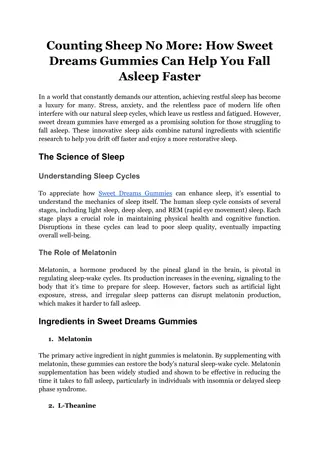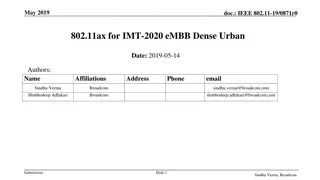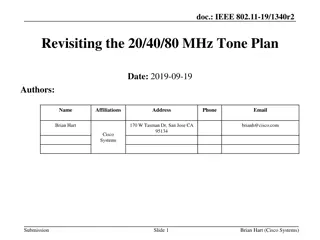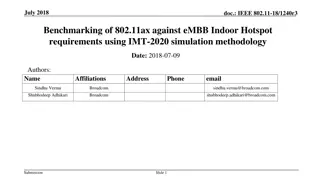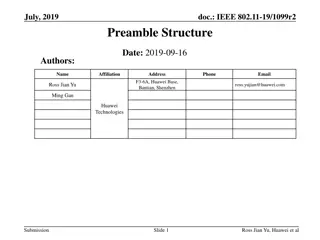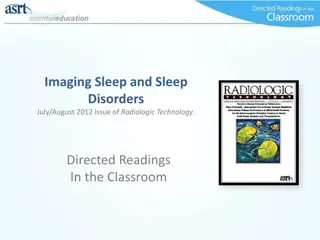IEEE 802.11ax Sleep States Analysis
This document delves into the analysis of sleep states in IEEE 802.11ax, emphasizing the need for refining current sleep state definitions to adhere to network conditions. It proposes various sleep states modifications to accommodate densification and low power operations, aiming to strike a balance between performance and energy efficiency in WLANs by considering different power consumption needs based on Wi-Fi device variations and traffic models.
Download Presentation

Please find below an Image/Link to download the presentation.
The content on the website is provided AS IS for your information and personal use only. It may not be sold, licensed, or shared on other websites without obtaining consent from the author.If you encounter any issues during the download, it is possible that the publisher has removed the file from their server.
You are allowed to download the files provided on this website for personal or commercial use, subject to the condition that they are used lawfully. All files are the property of their respective owners.
The content on the website is provided AS IS for your information and personal use only. It may not be sold, licensed, or shared on other websites without obtaining consent from the author.
E N D
Presentation Transcript
March 2015 doc.: IEEE 802.11-15/0314r2 Sleep States in IEEE 802.11ax Simulation Scenarios Date: 2015-03-09 Authors: Name Affiliations Address Phone email Chittabrata Ghosh Intel 2200 Mission College Blvd., Santa Clara, CA +1-4152448904 chittabrata.ghosh@intel.co m Chen Kojokaro Intel Eldad Perahia Intel Robert Stacey Intel Chinghwa Yu Mediatek chinghwa.yu@mediatek.c om chaochun.wang@mediate k.com Chao-Chun Wang Mediatek Submission Slide 1 Chittabrata Ghosh, Intel
March 2015 doc.: IEEE 802.11-15/0314r2 Contents of this Contribution Motivation for sleep states definition Need for refinement of current sleep state Sleep state classification Various sleep state illustrations Comparison of power and latency requirements for sleep states Submission Slide 2 Chittabrata Ghosh, Intel
March 2015 doc.: IEEE 802.11-15/0314r2 Scenario of 802.11ax Densification BSS 1 BSS 2 STA 2 AP 1 AP 3 AP 2 STA 1 OBSS Interference STA 4 STA 3 BSS 3 AP 4 Reception of a BU at STA 1 from AP 1 interfered by several UL traffic from STAs 2, 3, and 4 BSS 4 Communicating link Interfering link Submission Slide 3 Chittabrata Ghosh, Intel
March 2015 doc.: IEEE 802.11-15/0314r2 Motivation for Various Sleep States Definition Simulation Scenarios document [1] of IEEE 802.11ax specifies the following common power model parameters for all simulation scenarios Sleep power state is defined as the state when the STA is in Doze state and receiver is off Power State Average Current Consumption [mA] Transmit [mA] 280 Receive [mA] 100 Listen [mA] 50 Sleep [mA] 0.003 [2] Refinement of current sleep state to suit the network condition due to densification and low power operation We propose to define various sleep states where the receiver is partial or completely turned down We intend to include the proposed sleep states in the Simulation Scenarios document under Common Power Model Parameters for all simulation Scenarios [1] Submission Slide 4 Chittabrata Ghosh, Intel
March 2015 doc.: IEEE 802.11-15/0314r2 Need for Refinement of Current Sleep State Wi-Fi devices with various form factors Multitude of transmit power constraints Battery size requires different power consumption needs General categorization of sleep state may not be sufficient Different power management or power save protocols allow distinct short or long sleep times Constrained on power efficiency due to activation requirements of RF and baseband processors Leads to trade-off between performance and energy efficient WLANs Traffic models and latency requirements Sleep distribution based on disparate traffic models (bursty versus periodic, short or long packets, etc.) Multiple levels of sleep mode needed due to stringent (e.g., multimedia streaming, video conferencing) versus flexible (low duty cycle of UL or DL traffic) latency requirements Submission Slide 5 Chittabrata Ghosh, Intel
March 2015 doc.: IEEE 802.11-15/0314r2 Sleep State Classification Micro sleep state Decode the PHY Preamble and determine it is not a relevant packet and enter this sleep state for the duration of the PPDU; e.g., duration of a single UL or DL packet, spatial re-use in OBSS; Shallow sleep state Determine the protection duration from the first packet and enter this sleep state till end of that duration; e.g., TXOP duration Deep sleep state Sleep state over one or multiple beacon intervals ACK AP 2 Length of PPDU DL BU AP 1 Shallow sleep state Receive state STA1 TXOP Deep sleep state Micro sleep state UL Data STA2 Submission Slide 6 Chittabrata Ghosh, Intel
March 2015 doc.: IEEE 802.11-15/0314r2 Comparison of Power and Latency Requirements Among Different Sleep States Micro sleep state: MAC processor powered up, faster clock running, PLL ON, some leakage Power consumption around 5mW Latency to return to active state: 0-100us RF and modem OFF Shallow sleep state: MAC processor in retention mode, slower clock running, PLL in low power mode, some leakage Power consumption around 1mW Latency to return to active state: < 500us RF and modem OFF Deep sleep state: Wi-Fi power supply OFF Power consumption around 0-100uW Latency to return to active state: >3ms Submission Slide 7 Chittabrata Ghosh, Intel
March 2015 doc.: IEEE 802.11-15/0314r2 Proposal to Include Sleep States in IEEE 802.11ax Simulation Scenarios document Propose to include the following Table for 3 sleep states under Common Power Model Parameters for all simulation Scenarios in Simulation Scenarios document doc. IEEE 802.11-14/0980r6 [1] Sleep State Power and Latency Values Sleep State Power Consumption Latency from sleep mode to active state Micro Sleep 5mW 100us Shallow Sleep 0.9mA 500us Deep Sleep 0.003mA [2] 3ms Submission Slide 8 Chittabrata Ghosh, Intel
March 2015 doc.: IEEE 802.11-15/0314r2 Summary We have presented the need for refinement of current sleep state for Wi- Fi devices in IEEE 802.11ax We have proposed three sleep states based on the duration of sleep Micro sleep Shallow sleep Deep sleep Finally, we have proposed to modify the Simulation Scenarios by including a table specifying the 3 sleep states for better power and latency modeling Submission Slide 9 Chittabrata Ghosh, Intel
March 2015 doc.: IEEE 802.11-15/0314r2 References [1] IEEE 11-14/0980r6: TGax Simulation Scenarios [2] IEEE 11-14/1444r2: Energy Efficiency Evaluation and Simulation Model Submission Slide 10 Chittabrata Ghosh, Intel
March 2015 doc.: IEEE 802.11-15/0314r2 Straw poll 1 Which option do you prefer to add to the Simulation Scenarios document? Option 1: 2 sleep states (shallow and deep sleep) Y : 39 Option 2: 3 sleep states (micro, shallow, and deep) Y: 14 Submission Slide 11 Chittabrata Ghosh, Intel
March 2015 doc.: IEEE 802.11-15/0314r2 Straw poll 2 Do you agree to include the table under Common Power Model Parameters for all simulation Scenarios in the Simulation Scenarios document? Y: 33 No:0 A: 41 Sleep State Current and Latency Values Sleep State Current Consumption Latency from sleep mode to active state Shallow Sleep 0.9mA 500us Deep Sleep 0.003mA [2] 3ms Submission Slide 12 Chittabrata Ghosh, Intel








